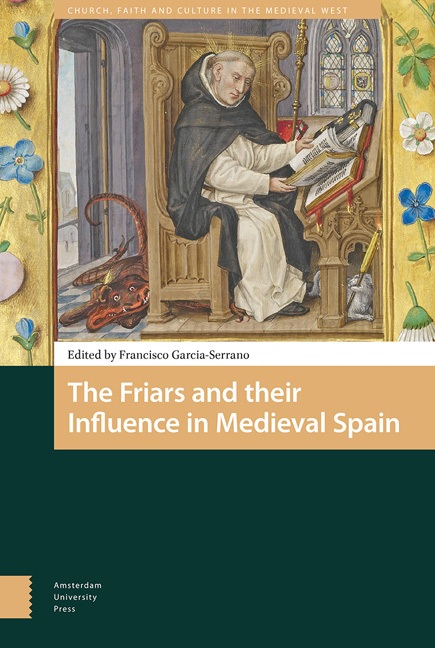Book contents
- Frontmatter
- Contents
- Abbreviations
- List of Illustrations
- Acknowledgements
- Introduction
- 1 Dominicus Hispanus
- 2 Ramon de Penyafort and His Influence
- 3 The Mendicant Orders and the Castilian Monarchy in the Reign of Ferdinand III
- 4 Ramon Marti, the Trinity, and the Limits of Dominican Mission
- 5 Narrative and Counter-Narrative: Dominican and Muslim Preaching in Medieval Iberia
- 6 The Poor Clares of Alcocer and the Castilian Crown (Thirteenth to Fifteenth Centuries)
- 7 Friars and Nuns: Dominican Economy and Religious Identity in Medieval Castile
- 8 Networks of Dissent and the Franciscans of the Crown of Aragon
- 9 Faction, Politics, and Dominican Inquisitors in the Fourteenth-Century Crown of Aragon
- 10 Sutzura e Viltat Carnal: The Place of Sin and Lust in the Treatises of the Franciscan Francesc Eiximenis (c.1400)
- 11 Valencian Dominicans Beyond the Convent of Santo Domingo
- 12 Ferdinand of Antequera and Santo Domingo el Real de Toledo: Patronage, Advice, and Spiritual Favour (c.1390–1416)
- Index
11 - Valencian Dominicans Beyond the Convent of Santo Domingo
Published online by Cambridge University Press: 16 February 2021
- Frontmatter
- Contents
- Abbreviations
- List of Illustrations
- Acknowledgements
- Introduction
- 1 Dominicus Hispanus
- 2 Ramon de Penyafort and His Influence
- 3 The Mendicant Orders and the Castilian Monarchy in the Reign of Ferdinand III
- 4 Ramon Marti, the Trinity, and the Limits of Dominican Mission
- 5 Narrative and Counter-Narrative: Dominican and Muslim Preaching in Medieval Iberia
- 6 The Poor Clares of Alcocer and the Castilian Crown (Thirteenth to Fifteenth Centuries)
- 7 Friars and Nuns: Dominican Economy and Religious Identity in Medieval Castile
- 8 Networks of Dissent and the Franciscans of the Crown of Aragon
- 9 Faction, Politics, and Dominican Inquisitors in the Fourteenth-Century Crown of Aragon
- 10 Sutzura e Viltat Carnal: The Place of Sin and Lust in the Treatises of the Franciscan Francesc Eiximenis (c.1400)
- 11 Valencian Dominicans Beyond the Convent of Santo Domingo
- 12 Ferdinand of Antequera and Santo Domingo el Real de Toledo: Patronage, Advice, and Spiritual Favour (c.1390–1416)
- Index
Summary
Abstract
By the late medieval period, Valencian Dominicans had become particularly concerned with preparing for the Last Judgement, which they believed was imminent. Such concerns were shared by other religious communities in late medieval Valencia. The Dominicans developed particularly close relationships with the Carthusian houses in the region, and works of art belonging to the Carthusians reflect ideas about the Last Judgement that were promoted by the Dominicans. These works reveal the extent to which the friars used the networks they developed to achieve their goal of preparing people for the end of the world.
Keywords: medieval Valencia, Dominicans, the Last Judgement
During James I's (1213–1276) campaign of territorial expansion in the Crown of Aragon, the king was often accompanied by his confessor, the Dominican friar Miguel de Fabra, who reportedly rode at James's side wearing his habit and brandishing a sword. James rewarded his confessor's steadfast loyalty by offering him a site on which to establish a convent in any city he chose within the king's territories. True to his word, following his conquest of the city of Valencia in 1238, the king gave the palace of the city's former Muslim ruler, Zayyan ibn Mardanish, to Miguel de Fabra as a site for a Dominican convent. The first stone for the new complex was laid by the king himself on 14 April 1239, marking the beginning of centuries of Dominican presence in the city and region of Valencia. Today, the building that once housed the Dominican convent is a parish church, with only a few remaining references in its art and architecture to its original purpose and inhabitants. Although little evidence of the medieval friars remains, careful consideration of the few extant primary visual and textual sources has revealed their historical importance in the region of Valencia and beyond.
In the decades following the establishment of their convent in Valencia, the friars of Santo Domingo became well known throughout the region, but their visibility increased at the close of the fourteenth century when one of their own, Vincent Ferrer, became involved in the Western Schism, supporting the Avignonese over the Roman popes. Ferrer rose to the position of apostolic confessor when Pedro de Luna, also a native of Iberia, became the Antipope Benedict XIII in 1395.
- Type
- Chapter
- Information
- The Friars and their Influence in Medieval Spain , pp. 247 - 270Publisher: Amsterdam University PressPrint publication year: 2018
- 1
- Cited by

